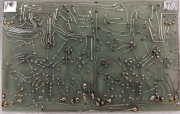If the 400 went into production in '71 how long was it produced as a 4 fin? When did they become 8 fin?
The Phase Linear 400 series 1 amplifier went into production in December 1971.
The change-over from the 4 fin to 8 fin heat-sinks occurred sometime around November 1974.
It was as a result of the
1/3rd power pre-conditioning for 1 hour as was required by the Federal Trade Commission "Power Output Claims for Amplifiers Utilized in Home Entertainment Products" (a.k.a. Amplifier Rule) 16 CFR Part 432 which was written May 3, 1974 and took effect six months later on November 4, 1974.
NOTE: This requirement was later relaxed and an article "FTC Eases Audio Amp Power Rule" appeared in Billboard magazine Oct 11, 1975.
"
...."However it is our opinion that use of the automatic recycling method permitting a piece of equipment to recycle (thermally cut off or on) automatically until 'on time' of one hour is accumulated is not inconsistent with the language of 3(c) and therefore constitute compliance with the Rule"
The verbiage on the front panels on the 400 and 700 were also changed in November 1974 as a result of the FTC's activities. (see paragraphs 6 and 7 in Billboard Oct 26,1974 article "Audio Firms Must Backup RMS"). As an example, the 400 series 1 sated "Four Hundred Watts R.M.S." and was changed to "Laboratory Standard Amplifier". Apparently Crown did not like this because their DC-300 stated "Laboratory Power Amplifier".
Further effects of the FTC spec upon the manufacturer's:
As was also stated in the Billboard magazine article:"
...many firms have had to de-rate stated power output capability or incorporate costly design changes."
Crown also added some clip-on heats-sinks for a while in an effort to meet the FTC spec. I have posted some pictures of this on another posting. Dynaco also modified their sales brochures and took out an ad in The Audio Amateur magazine 4/1974 . (see pdf below)
There is lots more to the story of the FTC "amplifier rule" which was relayed to me by A.P. Van Meter (former McIntosh, University Loudspeaker and Phase Linear chief design engineer). I may have already discussed this in one of my prior postings.
I also have dozens of articles relating to the debate than occurred during the early to mid 1970's concerning the FTC "amplifier rule".
It should also be noted that the FTC spec has been revised several times since 1974 and the pre-conditioning requirements have been further relaxed. If my memory serves me correct, the most recent
comments were released on January 26, 2010:
https://www.ftc.gov/sites/default/f...tainment-products/100126homeentertainment.pdf
Earlier documents may also further add to one's understanding:
December 22, 2000:
https://www.ftc.gov/sites/default/f...roducts/001222traderegulationrulerelating.pdf
July 9, 1998:
https://www.ftc.gov/sites/default/f...regulationrulerelatingtopoweroutputclaims.pdf
Ed









